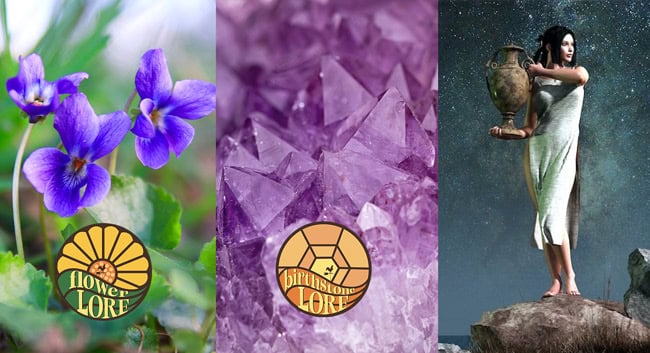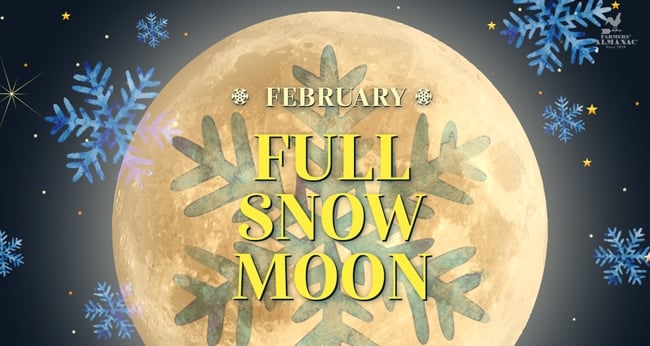February Birth Month Symbols And Fun Facts

Hello February! This month is all about cozy moments and peaceful thoughts. Let’s appreciate the calm and lovely side of the February birth month by learning what makes it special. The Farmers’ Almanac invites you to check out all the different signs and February symbols: flowers, stones, zodiac signs, herbs and bird of the month, and more! Get ready to learn some February fun facts and bits of knowledge that will excite you. Share what you love about February (and your photos) in the comments, and let’s all enjoy this amazing month together!
February Birth Month Symbols
February birth month is adorned with vibrant symbols that reflect its unique character. The color popping bloom, the violet, symbolizes faithfulness and remembrance, while the amethyst birthstone enhances awareness and spirituality, providing much-needed warmth and energy during this cold, dark month. Aquarius and Pisces stand as the month’s zodiac guardians, bringing innovation and intuitiveness to those born during this time. The chickadee, February’s bird of the month, exhibits resilience and camaraderie amidst adversity, embracing hope and renewal during the wintry month. Additionally, fennel, sage, and other healing herbs are associated with February, adding layers of meaning to this special month.

February Birth Month Flower: Violet
Violets, the flower for those born in February, are steeped in meaning and old stories. With over 650 types, these little flowers charm us with their sweet smell and heart-shaped leaves. They come in shades from soft purple to deep blue, each color meaning something different. Violets grow all over the world in forests and are known by names like pansies and “hearts-ease,” showing how important they are in many places.
These flowers mean different things to different people. In Native American stories, they stand for togetherness and steadiness, while in the old Victorian language of flowers, they’re about trust and calm. But they also remind people of sadder times, like funerals. Violets are tied to star signs, weddings, and religious ideas, making them important in many parts of life and history.
In Christian folklore, violets are a sign of being pure and are often linked to the Virgin Mary. Greek myths tell us they’re about protection and big changes. The rich purple color of violets is also linked to kings and queens and the idea of being noble.
Related: Birth Month Flowers: Plant A Family Garden
Violets are not just one of February’s symbols. They’re also tasty and good for you! You can eat them in salads, teas, and sweets, and they’re full of good stuff that helps with things like sore joints and headaches. Gardeners love them because they’re tough and have beautiful flowers. Even though we connect violets with February, their charm really lasts all year, touching people with their timeless grace and deep meanings.
Read more about violet flower symbolism

February Birthstone: Amethyst
Amethyst, celebrated as the birthstone for February, has a fascinating past rooted in various traditions. Originating from the Greek term “amethystos” which means “not drunk,” it’s been long connected to the wine god Bacchus and thought to prevent drunkenness. The gemstone’s importance reaches back to ancient Egypt, where it was used in protective amulets and found in the royal tombs of leaders like King Tutankhamen, symbolizing spiritual and protective qualities.
Related product: February Birthstone Amethyst Necklace
This gemstone has many mythical ties. According to Greek stories, it symbolized clear thinking and caution, particularly in conflict and business. Christians saw it as a symbol of healing, relating it to the purple robe of Christ and a special breastplate. It’s also linked to love, as St. Valentine himself is said to have worn a ring with Cupid etched in amethyst.
Renowned individuals from the past like Leonardo da Vinci to present-day icons have been drawn to its charm, which embodies bravery, peace, and the search for deeper awareness. Today, amethyst is still admired for its beauty and supposed power to bring calm, clear thinking, and spiritual growth, making it a treasured stone that represents wisdom, nobility, and the quest for inner peace.
Related: See all birthstones by month
February Colors: Purple, Light Blue, Yellow, And Pink
The purple color for the February birth month derives from the birthstone and birth flower of the month. While purple is a symbol of wealth and royalty, it can elicit feelings of happiness and luxury. Light blue can make you feel calm, while yellow, associated with sunshine, brings cheerfulness and creativity, and can help sharpen memory and confidence. Reds and pinks are also associated with the month of February, the month of love, since these colors represent romance.

Full Snow Moon
The February full Moon, or “Snow Moon,” has various names that reflect the cold season and cultural stories. Names like “Deep Snow Moon” and “Ice Moon” describe the chilly February weather, while “Hunger Moon” points to the tough times for food during winter.
February’s Moon can also be a “Black Moon,” when there’s no full Moon, which is rare and will happen in 2037. In 2048, an unusual event will occur when the full Moon falls on February 29, Leap Day, something that happens only every 400 years. These special lunar features add to the lore and spark our interest in the night sky’s cycles.
Learn more about the Full Snow Moon
Related: 2023-24 Full Moon Dates And Times
February fun fact:
- February is the only month where it’s possible to go the entire time without having a full Moon.
Zodiac Signs: Aquarius and Pisces
Two zodiac signs are associated with the February birth month: Aquarius and Pisces.

Aquarius (January 20-February 18)
Despite the name “aqua” in its name, Aquarius is the last air sign of the zodiac. Creative, innovative, and progressive, Aquarians are represented by the water bearer. They can seem detached and distant, driven by reasoning and concrete evidence, rather than others’ emotions. What can be mistaken as apathy is a deeply analytical and logical sense of the world, allowing Aquarians to form unique perspectives on human relationships and society. They desire diverse social interactions, helping to enrich their understanding of the world.
Related: What Is Your Zodiac Sign?
Aquarians’ eccentric and inventive nature allows them to think outside the box, leading to unique approaches and solutions. While this may be someone you want on your team, their overly focused viewpoint can sometimes make them quite stubborn. This inflexibility is a double-edged sword, as their innovativeness can also lead to conflict when they are challenged. Despite these challenges, their unique approach to life makes them one of the most interesting zodiac signs.
Related: Learn more about Aquarius
Pisces (February 19-March 20)
Pisces is the twelfth constellation of the zodiac. Its name is the Latin word meaning “fishes.” Highly creative and imaginative, as well as compassionate and loving, Pisces is a water sign, the final of the zodiac and is symbolized by the fish. Intuitive and emotional, Pisces are often described as old souls, with an innate connection to the spiritual world, being drawn to romantic and creative experiences. People born with this zodiac sign are often particularly sensitive and compassionate, putting the needs of others before themselves.
What’s the difference between astrology and astronomy? Find out!
Pisces generally prioritize their social life and make excellent friends, and their emotional sensitivity can help them tune into other’s feelings that many people often ignore. Pisces go-with-the-flow and thrive on spontaneity. They succeed in career positions that require creativity and intuition, in which they can help others. While they often seem lost in their own imagination, once a Pisces decides to commit, they will give it their all.
Characterized as the most sensitive of the zodiac signs, Pisces are particularly sensitive to criticism and have a tendency to develop people-pleasing tendencies. A Pisces is the gentlest of the zodiacs and their view of the world is often through rose-colored glasses, believing that everyone deserves kindness and respect. A Pisces is someone you want in your corner of life.
Related: Learn more about Pisces
February Herbs of the Month
The link between herbs and star signs comes from the idea that the qualities of herbs match up with the personality traits of each star sign. People who study astrology and herbs believe that herbs have special strengths or helpful effects that go well with certain zodiac signs.
Some herbs are connected to specific zodiac signs because they are thought to boost the good qualities of people born under those signs or to help with the problems they often run into. This connection highlights the idea that herbs and star signs work well together, giving importance to the idea that herbs can help and even out the traits of each star sign.
- Aquarius herbs (Jan-Feb): Fennel, the primary herb for Aquarius, is a perennial herb grown for both culinary and ornamental purposes, making an attractive border plant, as well as a great addition to butterfly gardens. Fennel, derived from Foeniculum, coming from the Roman meaning “fragrant hay.” The plant bears small yellow flowers in the summertime. Fennel has a licorice-like taste and aromatic seeds that can be harvested along with the foliage, with the whole plant being used for medicinal and culinary purposes. Fennel has a wide range of uses and many believe it helps with improved respiratory function, alleviating menstrual symptoms, and aiding in digestion. Ancient Romans, Greeks, Egyptians used fennel as part of their ceremonies as a symbol of wealth and pleasure. Queen Anne’s lace, clove, comfrey, rosemary, violet, and valerian are other herbs associated with Aquarius.
- Pisces herbs (Feb-March): The sweet, yet savory herb, Sage, is the primary herb for Pisces. Sage, native to the Mediterranean, is a staple herb across many cultures, dating back centuries. Sage’s botanical name comes from the Latin word salvere, meaning “to be saved.” Its strong aroma and early flavor lends well to many culinary uses, while also being packed with nutrients and compounds, which have been known to promote oral health, brain function, while also potentially lowering cholesterol and blood sugar. Sage has a rich history in medicinal and culinary uses, with it being a popular tea option in China in 812 AD. In Ancient Rome it was deemed an integral component in Roman pharmacopeia, to heal wounds, stop bleeding, soothe sore throats, and aid in digestion. Sage is also commonly used as a ritual object in spiritual sage burning or smudging, an ancient tradition that involves burning sage leaving and using the smoke to cleanse or purify spaces, objects, and even people. Other herbs associated with Pisces: mugwort, basil, lemon balm, borage.
February Birth Month Bird: Chickadee
The chickadee, a charming little bird, is perfect for representing February because it thrives in winter. These birds don’t flee to warmer places. Chickadees keep busy searching for food and holding down their home turf, reminding us that life keeps going even when the weather outside isn’t that inviting.
But what makes chickadees even more fascinating is their social nature. They’re super friendly, sticking together in groups to make it through winter. Their cheerful chirps and quick movements give us a boost, making us think of spring and fresh starts even in the depths of winter.
Across different cultures, the chickadee and other birds are symbols of hope and hanging in there.
Fun Bird Facts:
- Chickadees have remarkable memory skills, particularly when it comes to storing and retrieving food. They are known to store food in various locations and rely on their spatial memory to retrieve it later, even months afterward.
- Chickadees have complex vocalizations and are capable of producing a wide range of calls. One of the most distinctive calls is the “chick-a-dee-dee-dee,” which which some people interpret as sounding like “cheeseburger” (cheese-bur-ger). This is why chickadees are nicknamed the “cheeseburger bird.”
- In the US, February is recognized as National Bird-Feeding Month.
What Does “February” Mean?
February is unique among the months because it doesn’t get its name from Roman gods. It comes from an old Roman cleaning festival called Februalia, where people would wash themselves as a way to start fresh. So, the name February reminds us it’s a time for getting rid of the old to welcome spring and enjoy longer days if you’re in the Northern part of the world.
Long ago, the people in England called February “cake-month” (Sol-monath) because they would give cakes to their gods. They also named it after the early sprouting of cabbages, calling it “sprout-kale.” In Wales, they sometimes call February “the little month” (y mis bach), which makes sense because it’s shorter than the rest and feels like a quick step before spring begins.
February Fun Facts:
- February is one of the most misspelled words in the English language.
- In the Middle Ages, young men and women would draw names to see who their Valentine would be. They would wear this name pinned to their sleeves for a week for everyone to see. This is believed to be the origin of the expression “to wear your heart on your sleeve.”
Related: How Did The Months Of The Year Get Their Names?
February Calendar
In the original Roman calendar, there were ten months with a total of 304 days. To better match the Moon’s cycles, King Numa Pompilius added January and February to the calendar. Back then, Romans thought even numbers were bad luck. To avoid them, Numa took away a day from the months that had 30 days, making the months switch between 29 and 31 days. But this left the calendar with 354 days, another even number, which was a no-go.
To fix this, one month had to end up with an even number of days, and that’s how February got stuck with 28 days. In February, Romans held ceremonies to remember those who had passed away. Over time, even though the calendar went through many changes, February has stayed as the shortest month in the calendar we all use now.
Why is an Extra Day (leap day) Added in February?
Leap Years occur every fourth year on the Gregorian calendar, adding an extra day to the calendar year, known as leap day, observed on February 29th. This additional day ensures that from March onward, each date of a leap year progresses by an extra day compared to the previous year. For instance, a date like March 10, 2023, which fell on a Thursday, would shift to a Saturday in 2024, a leap year. This adjustment effectively skips a day, instead of the usual one-day forward movement.
While the concept of “leaping” may seem trivial, it serves a crucial purpose. The Gregorian calendar year, with its 365 days, is slightly shorter than the solar year, which spans approximately 365.24 days—the time it takes for the Earth to complete one orbit around the Sun. Leap years compensate for this discrepancy, preventing a gradual shift in the timing of the seasons. Without leap years, over time, the seasons would drift out of sync. According to The National Air and Space Museum, if leap years were discontinued, in 700 years, the Northern Hemisphere’s summer would begin in December instead of June.
However, the leap year system isn’t flawless. It results in a surplus of 44 extra minutes every four years, equating to an extra day every 129 years. To address this inconsistency, leap years are skipped every centenary year, except for those divisible by 400, such as 1600 and 2000.
RELATED: Read more about Leap Year
February Fun Fact:
- Do you have a February birthday? The odds of being born on February 29 are about 1 in 1,461. Those born on a Leap Day is sometimes called “leapers” or “leaplings.” Do you know a leapling? Share with us in the comments below!
February Weather Lore
February brings a variety of weather conditions to most of the country, including snow, tornadoes, and changes in temperature as spring nears. February is the snowiest month of the year for many locations, especially California’s Sierra Nevada Mountains.
Related: Snow Myths And Odd Facts
February can also bring a giant mess, including ice storms, to other parts of the country as cold air travels over warm pockets across the South. Even if winter weather dominates during the month of February, longer days of sun makes it more bearable and serves as a reminder that spring is around the corner.
Psst … have you seen our Spring Extended Weather Forecast?
Related: Farmers’ Almanac Long-range Weather Predictions
Here is some popular February weather folklore:
- Groundhogs’ Day falls on the second day of February. The groundhog, Punxsatawney Phil, is supposed to leave his burrow in Punxsatawney, Pennsylvania. If he doesn’t see his shadow, it means spring is on the way. But if he does see his shadow, he returns to his hole because six more weeks of winter are coming.
- One Scottish proverb suggests that fine weather at the start of the month might not last long: “If the laverock (skylark) sings afore Candlemas (a Christian holiday that coincides with Groundhogs Day), she’ll mourn as lang (long) after it.”
- Similarly, a piece of popular February weather lore states, “If Candlemas Day (February 2) be fair and bright, winter will have another flight. But if it be dark with clouds and rain, winter is gone, and will not come again.”
- “If the weather be fine and frosty at the start of February, there is more winter ahead than behind.”
- The days of February 12-14 are said to be borrowed from the month of January and so it was expected that the weather should be cold and January-like. Stormy winter weather on these days foretold fair weather for the rest of the year. Conversely, if these days are pleasant, or indeed if any days in February are too pleasant, it indicates poor weather for the rest of the year.
- “When the cat lies in the sun in February, she will hide behind the stove in March.”
February Night Sky
Step outside on a February night and enjoy a beautiful star show that makes the cold worthwhile. Around 9 p.m. local time, look to the southern sky to see the “Great Winter Hexagon,” a pattern of bright winter stars.
Related: Monthly Stargazing Night Sky Guide
Gardening: Start Planning
February is when people start getting ready for their spring garden, even though it’s still cold. Here is how to prepare:
Garden Planning: This is a great time to think about how you want your garden to look. Decide which plants you want to grow, figure out the best spots for them based on sunlight and the type of soil, and plan any changes or new things you want to add to your garden.
Buying Seeds and Tools: Look through seed catalogs or websites to pick out the seeds you want for your garden. Order them now so you can get the types you want, especially if they’re popular or special old varieties. Also, make sure you have all the gardening tools and supplies you need, like soil, pots, seed trays, and tools.
Planting Seeds Inside: Some plants do better if you start them inside before moving them to the garden. Set up a space with enough light and warmth for your seeds. Start with plants that need a longer time to grow, like tomatoes, peppers, and some flowers, but be sure to check how long they take to germinate and when your last frost is.
Related: Farmers’ Almanac Gardening By The Moon Calendar
Getting the Soil Ready: If the weather’s not too bad, you can clean up your garden beds, get rid of weeds and old plants, and make the soil better by adding compost or old manure.
Using Cold Frames or Hoop Houses: You can use these structures to keep your garden going longer and protect plants that can’t handle the cold. They let you start planting earlier and keep young plants safe from frost.
Trimming Plants: Now is the time to cut back trees and bushes while they’re still not growing. Get rid of dead branches, shape the plants for better growth, and trim any that are too big.
Learning More About Gardening: Use the winter to learn more about how to garden well, take care of plants, and handle pests in your area. You can go to gardening classes, read up on it, or ask local gardening professionals for advice.
Best wishes with getting a head start on your spring gardens!
Recipes For February
Stay warm and healthy with some of these Farmer’s Almanac favorites:
February Trivia
- The first United States postage stamp was issued on February 1, 1842.
- The 19th Amendment, granting women the right to vote, was passed by Congress on February 27, 1922.
Join The Discussion
Were you born in February?
Which symbols for February are your favorite?
Do you know any interesting February fun facts, symbols, or folklore not mentioned above?
Share with your community here in the comments below!







I went to school with 3 Leap Year babies!